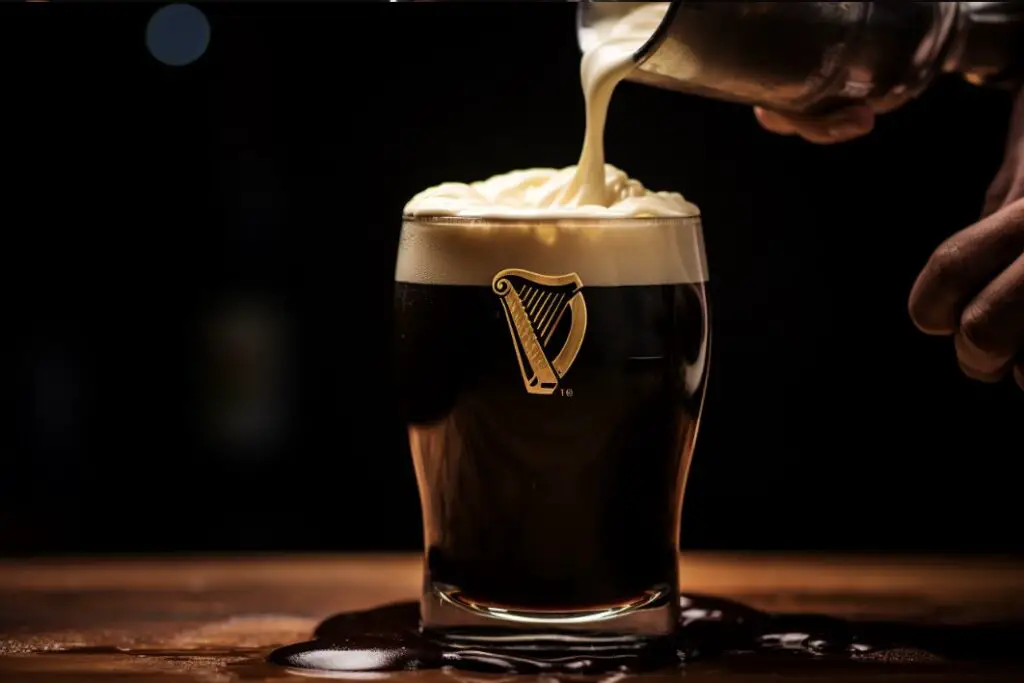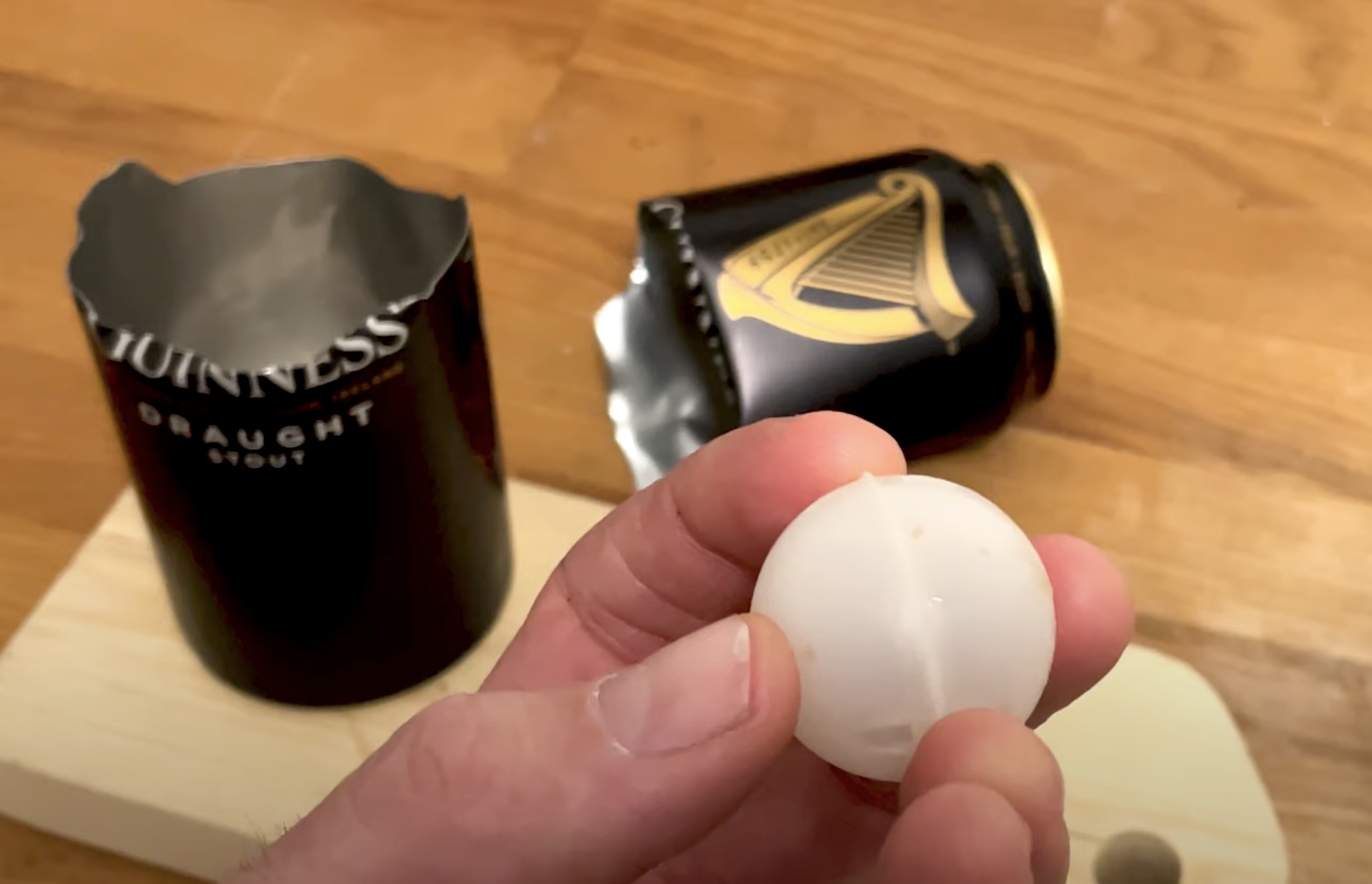If you’ve ever opened a can of Guinness Draught, you may have noticed a small plastic ball, or ‘widget’, bouncing around inside.
It may seem perplexing to find a plastic ball in Guinness beer cans, but there is a method to this madness. The introduction of this unusual addition serves a specific purpose that goes beyond mere packaging.
While it may seem strange at first, this little ball plays a crucial role in maintaining the unique texture and flavour of Guinness.
The plastic ball, or ‘widget’, in a Guinness beer can releases nitrogen when the can is opened, replicating the draught beer experience.
As we examine the phenomenon further, it becomes evident that this plastic ball, known as a “widget,” has revolutionized the way Guinness beer is enjoyed.
Inside each can, carefully concealed within its liquid contents, lies this small yet significant device. When the can is opened and poured into a glass, magic happens as the widget springs into action.
The purpose of this widget is twofold:
- It serves to recreate the iconic creamy head that Guinness draught beer is renowned for. By releasing gas upon opening, it creates a cascade effect within the liquid, resulting in a thick and frothy foam forming atop your pint. This not only adds to its aesthetic appeal but also enhances its smooth and velvety texture.
- The widget aids in preserving nitrogenation levels and ensuring that every sip bursts with lively bubbles. By slowly releasing nitrogen gas during pouring, it mimics the experience of being poured directly from a tap at your favorite pub. This innovative technology allows supporters of Guinness to enjoy their favorite brew with all its authentic qualities intact.
So next time you crack open a can of Guinness and see that little plastic ball nestled inside, remember its important role in bringing you an authentic and satisfying drinking experience. Don’t miss out on this unique feature that sets Guinness apart from other beers.
The Role of Nitrogen in Guinness
Guinness is a stout beer originally from Ireland, and it’s known for its creamy, velvety texture, which is a result of the use of nitrogen gas.

Unlike other beers, which are often carbonated with carbon dioxide, Guinness uses a mix of CO2 and nitrogen – about 70% nitrogen and 30% carbon dioxide. This blend results in smaller bubbles, creating a creamier, smoother mouthfeel. Nitrogen is less soluble in liquid, which means it forms smaller, more stable bubbles in the beer.
However, nitrogen presents some challenges when it comes to packaging the beer. Because nitrogen doesn’t dissolve well in liquid, it can be difficult to incorporate it into the beer. This is where the plastic ball, or widget, comes into play.
The Invention of the Widget
In the late 1980s, Guinness started looking for a way to replicate the draught beer experience in a can.
They wanted consumers to enjoy the same creamy, smooth texture of Guinness served from a tap, even when they were drinking canned beer at home. The solution to this problem was the invention of the widget.

The widget is a small, hollow plastic ball that is inserted into the can before it’s sealed. The can is then pressurised with nitrogen gas.
When the can is opened, the pressure drops, causing the widget to release a small amount of liquid nitrogen.
This creates a surge of tiny bubbles that forms the beer’s characteristic creamy head.
Other Guinness Beer Can Milestones
Guinness beer cans have an intriguing history that spans decades. To understand the evolution of these iconic cans, let’s delve into some interesting details.
The History of Guinness Beer Cans has been marked by innovation and a commitment to preserving the quality of the iconic Irish stout.
Taking a step back in time, we can explore the different stages Guinness beer cans have undergone.
| YEAR | SIGNIFICANT DEVELOPMENT |
|---|---|
| 1930 | The first-ever Guinness beer can was introduced, featuring a cylindrical shape with a flat top and bottom. |
| 1963 | The flat top was replaced with a pull-tab design, making it easier to open and enjoy Guinness on-the-go. |
| 1989 | The introduction of the widget revolutionized the Guinness can. This plastic ball, known as the “floating widget,” releases nitrogen when the can is opened, replicating the creamy draught experience. |
| Present | Today, Guinness beer cans continue to be an icon in the beer industry. Their innovative designs and commitment to quality ensure that every sip delivers unrivaled flavor. |
Beyond these fascinating milestones, an anecdote presents itself from the early days of the widget’s development.
The Science Behind the Widget
The widget works thanks to some basic principles of physics. When the can is sealed, the widget is filled with beer and pressurised nitrogen gas. The high pressure forces some of the nitrogen to dissolve into the beer.
When the can is opened, the pressure inside the can drops quickly, which allows the nitrogen in the widget to decompress and form bubbles.
These bubbles rush to the top of the can, agitating the rest of the nitrogen in the beer and creating the surge of bubbles that forms the head of the beer.
The Impact of the Widget on the Beer Industry
The invention of the widget had a significant impact on the beer industry. It allowed Guinness to offer something unique – a canned beer that actually tasted like it was fresh from the tap.
This innovation revolutionised the beer industry and allowed Guinness to maintain its distinctive identity in a competitive market.
Other beer companies have since adopted similar technologies. Some use a similar widget, while others use a nitrogen-infused liner in the can. These innovations have all been attempts to capture that fresh-from-the-tap experience.
The Environmental Impact of the Widget
While the widget has been an important innovation for Guinness, it’s not without its drawbacks. The widgets are made from plastic, which contributes to environmental pollution.

However, Guinness is committed to finding more sustainable alternatives.
They have recently announced a plan to eliminate plastic from their beer packaging, including the widget. They’re currently researching alternative materials and methods to maintain their unique beer experience without contributing to plastic waste.
Conclusion: The Importance of the Widget in Guinness Beer Cans
The plastic ball, or widget, in Guinness beer cans is a crucial part of what makes Guinness unique. It allows the beer to maintain its creamy, smooth texture, even when it’s served from a can. While the widget does contribute to plastic waste, Guinness is actively working on finding more sustainable alternatives.
Here are 10 facts about the widget in Guinness beer cans:
- The widget is a small, hollow plastic ball that releases nitrogen when the can is opened.
- The widget was invented by Guinness in the late 1980s.
- The widget allows Guinness to replicate the draught beer experience in a can.
- The widget works thanks to basic principles of physics.
- When the can is opened, the pressure drop allows the widget to release a surge of nitrogen bubbles.
- This surge of bubbles creates the creamy head that Guinness is known for.
- The invention of the widget revolutionised the beer industry.
- Other beer companies have since adopted similar technologies.
- The widget is currently made from plastic, which contributes to environmental pollution.
- Guinness is researching more sustainable alternatives to the plastic widget.
From my personal experience, the plastic ball in Guinness cans does make a noticeable difference. The beer tastes smoother and richer, and the creamy head is a delight to behold. It’s an excellent example of how a little innovation can have a big impact on the quality of a product. It’ll be interesting to see how Guinness continues to innovate in the future, especially in their efforts to create a more sustainable widget.
FAQs
How does the Guinness Nitro surge work?
The Guinness Nitro surge works by using a special nitrogen-infused widget inside the can. When the can is opened, the pressure inside causes the widget to release tiny nitrogen bubbles into the beer, creating a cascading effect and a creamy head. This enhances the texture and taste of the beer, giving it a smooth and velvety mouthfeel.
Are Nitrosurge cans worth it?
Yes, Nitrosurge cans are worth it. They provide a convenient and efficient way to enhance athletic performance and energy levels.
What’s the difference between Guinness and Guinness Nitrosurge?
Guinness and Guinness Nitrosurge are two different variations of the same iconic Irish stout. The main difference lies in the carbonation method used. Guinness is traditionally carbonated with carbon dioxide (CO2), resulting in a smooth and creamy texture. On the other hand, Guinness Nitrosurge is infused with nitrogen (N2) in addition to CO2, creating smaller bubbles and a velvety mouthfeel. This nitrogen infusion gives Nitrosurge a unique cascading effect when poured, and a richer, creamier taste compared to regular Guinness.
Do you shake Guinness Nitro?
No, you should not shake Guinness Nitro.
Does Guinness Nitrosurge work on normal cans?
Yes, Guinness Nitrosurge can work on normal cans.
Is Guinness the same in a can?
Yes, Guinness in a can is generally the same as Guinness served on tap.




